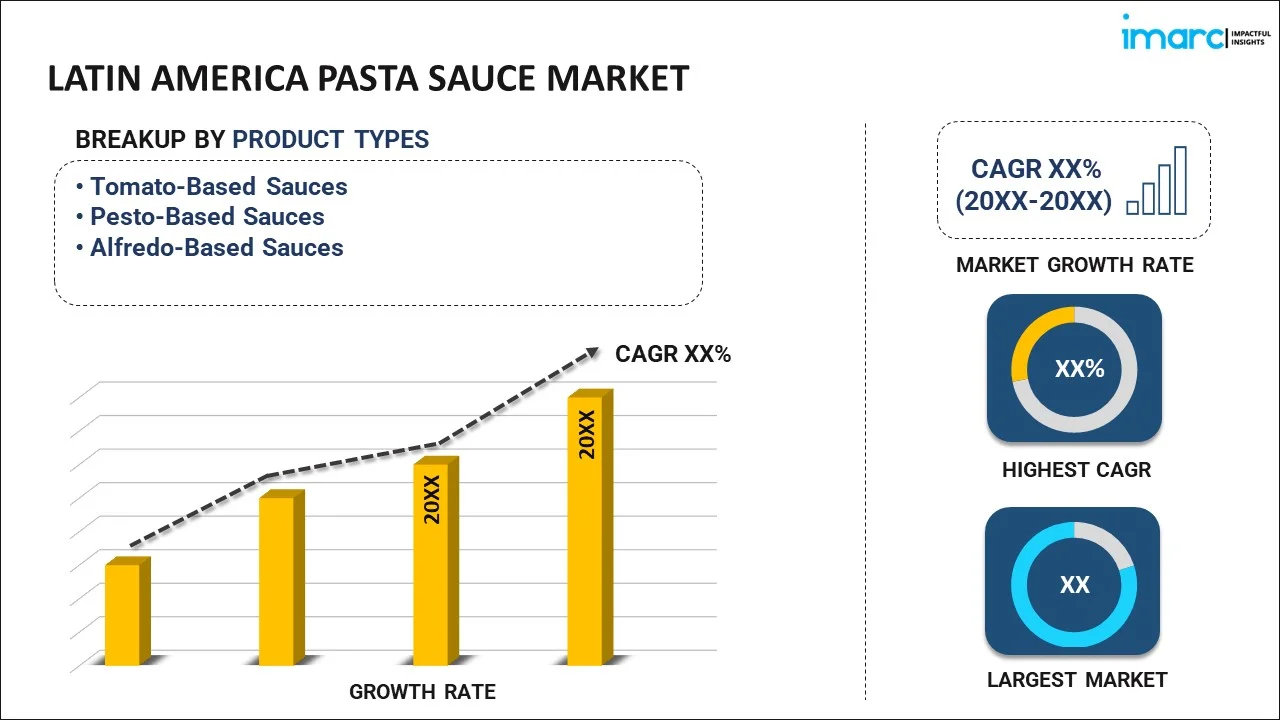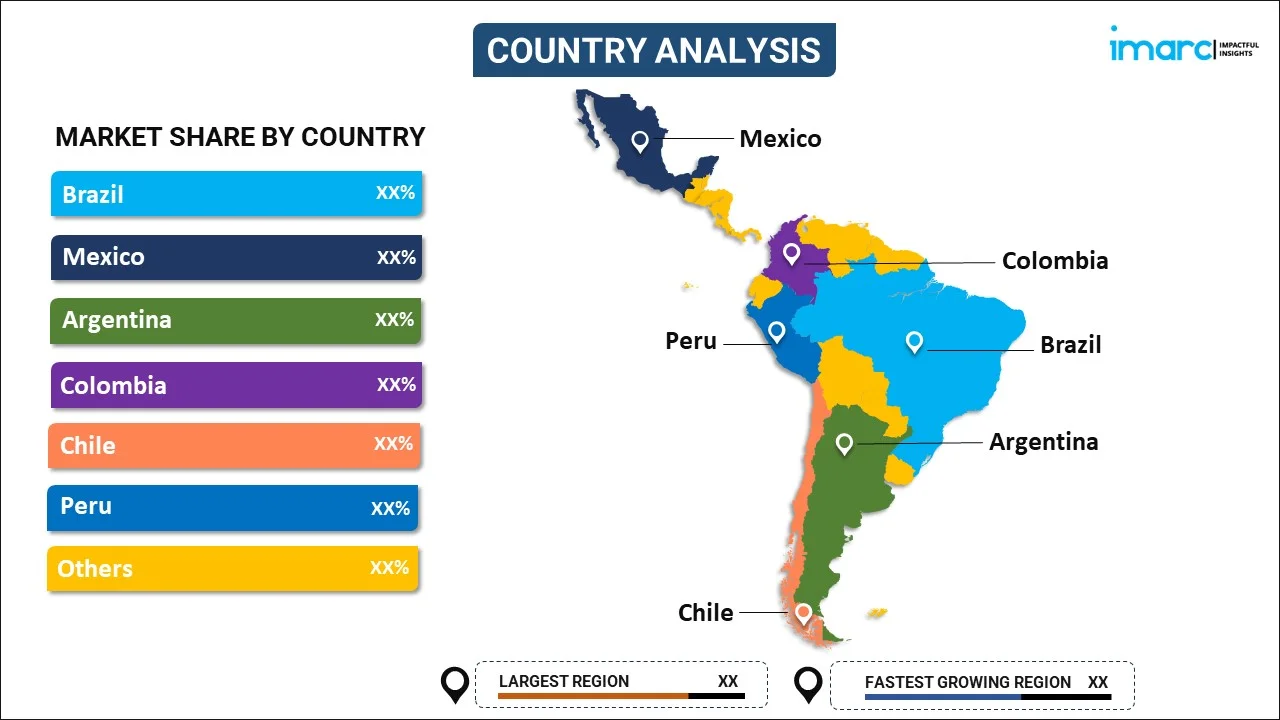
Latin America Pasta Sauce Market Report by Product Type (Tomato-Based Sauces, Pesto-Based Sauces, Alfredo-Based Sauces), Packaging Type (Glass Bottles, PET, Cans, Pouches, Cartons), Distribution Channel (Direct, Indirect), and Country 2025-2033
Market Overview:
The Latin America pasta sauce market size reached USD 900.1 Million in 2024. Looking forward, IMARC Group expects the market to reach USD 1,332.2 Million by 2033, exhibiting a growth rate (CAGR) of 4.23% during 2025-2033. The market is growing due to increasing urbanization, rising disposable incomes, and a shift toward convenient, ready-to-eat meals. Demand is further driven by the popularity of international cuisines, product innovation, and expanding retail channels, making pasta sauces more accessible across diverse consumer segments in the region.
|
Report Attribute
|
Key Statistics
|
|---|---|
|
Base Year
|
2024
|
|
Forecast Years
|
2025-2033
|
|
Historical Years
|
2019-2024
|
|
Market Size in 2024
|
USD 900.1 Million |
|
Market Forecast in 2033
|
USD 1,332.2 Million |
| Market Growth Rate 2025-2033 | 4.23% |
Pasta sauce is a cream-based liquid or semi-solid paste prepared from a mixture of ingredients like tomatoes, onion, garlic, cheese, herbs, and other seasonings. It is a rich source of micronutrients, vitamins, minerals, and fibers and is available in different variants such as red, green, meat-based, emulsified, butter-based, vegetable, and white sauce pasta. In Latin America, the demand for pasta sauce is escalating on account of the availability of a wide range of pasta sauces in innovative packaging formats, such as glass and aluminum containers.
Latin America represents one of the leading pasta sauce markets across the globe. The market is primarily driven by the rising inclination toward intercontinental cuisines among the masses. The growing food and beverage industry and the increasing preference for ready-to-eat food products are further propelling the pasta sauce market growth. Among the most popular products is tomato pasta sauce, widely used across households and restaurants alike. Moreover, manufacturers are introducing new variants, such as gluten-free, vegan pasta sauce, and organic varieties, which are extensively used in various restaurants, cafes, and eateries. Among these, the growing demand for vegan pasta sauce market is driven by increasing consumer preference for plant-based options. Furthermore, the growing health-consciousness among individuals has resulted in increased demand for nutrient-rich and healthy products, accelerating the organic pasta sauce Latin America segment.
Latin America Pasta Sauce Market Trends:
Rising Demand for Convenience Foods
Urbanization and fast-paced lifestyles in Latin America are driving a strong shift toward convenient meal solutions, including ready-to-use pasta sauces. Consumers increasingly prefer products that reduce cooking time without compromising taste or quality. Pasta sauces fit this trend perfectly, especially those that come in resealable jars or pouches and are available in various flavors. This is particularly evident among working professionals and younger demographics in countries like Brazil, Mexico, and Argentina. Additionally, the growth of e-commerce and online grocery platforms further enhances access to a wide variety of sauce options. This convenience-driven demand is pushing manufacturers to innovate and offer more premium, ready-to-eat sauce varieties with longer shelf lives and attractive packaging.
Health-Conscious and Clean Label Preferences
Latin American consumers are showing growing awareness of nutrition, leading to an increased demand for healthier pasta sauce options. Products that are organic, low in sugar or sodium, gluten-free, or free from artificial preservatives are gaining traction. Brands are responding by offering "clean label" sauces with transparent ingredient lists, locally sourced vegetables, and reduced fat content. Additionally, plant-based and vegan-friendly sauces are emerging, aligning with global health trends and lifestyle changes. Chile and Colombia, for example, have seen a rise in demand for sauces enriched with herbs, antioxidants, and superfoods. These healthier formulations are not only marketed for wellness but also cater to dietary restrictions, thus broadening their consumer appeal across various age groups.
Regional Flavor Innovations and Localization
As Latin American tastes diversify, there's a growing trend of localizing pasta sauce flavors to match regional palates. Consumers increasingly seek unique and culturally relevant flavors such as chipotle-tomato blends, roasted pepper sauces, or sauces infused with native spices and herbs. This has encouraged both global and local manufacturers to develop sauce variants that incorporate traditional Latin flavors while maintaining Italian roots. In Mexico and Peru, for instance, sauces are often spiced to reflect regional cuisine preferences. This flavor adaptation not only enhances consumer engagement but also boosts brand loyalty by offering products that feel familiar yet novel. This trend highlights the importance of culinary fusion in product development within the Latin American pasta sauce market.
Key Market Segmentation:
IMARC Group provides an analysis of the key trends in each sub-segment of the Latin America pasta sauce market report, along with forecasts at the regional and country level from 2025-2033. Our report has categorized the market based on product type, packaging type and distribution channel.
Breakup by Product Type:

- Tomato-Based Sauces
- Traditional Sauce
- Marinara Sauce
- Meat Sauce
- Mushroom Sauce
- Roasted Garlic Sauce
- Cheese Sauce
- Tomato and Basil Sauce
- Others
- Pesto-Based Sauces
- Traditional Basil Pesto Sauce
- Sun-Dried Tomato Pesto Sauce
- Others
- Alfredo-Based Sauces
- Traditional Alfredo Sauce
- Garlic Alfredo Sauce
- Cheese Alfredo Sauce
- Others
Breakup by Packaging Type:
- Glass Bottles
- PET
- Cans
- Pouches
- Cartons
Breakup by Distribution Channel:
- Direct
- Indirect
- Store-Based Retailing
- Supermarkets
- Specialty Stores
- Convenience Stores
- Online Retailing
Breakup by Country:

- Brazil
- Mexico
- Argentina
- Colombia
- Chile
- Peru
- Others
Competitive Landscape:
The competitive landscape of the industry has also been examined along with the profiles of the key players.
Latin America Pasta Sauce Market News:
- In April 2025, Botticelli Foods, a US-based, Italian-made brand, rapidly expanded its pasta sauce business. The company sources ingredients and manufactures exclusively in Italy, maintaining a premium, authentic Italian identity. They have warehouses across the US and are entering the organic coffee market with a new product line. Botticelli exports to Latin America and Japan but remains primarily focused on the US market.
Report Coverage:
| Report Features | Details |
|---|---|
| Base Year of the Analysis | 2024 |
| Historical Period | 2019-2024 |
| Forecast Period | 2025-2033 |
| Units | Million USD |
| Product Types Covered | Tomato-Based Sauces, Pesto-Based Sauces, Alfredo-Based Sauces |
| Packaging Types Covered | Glass Bottles, PET, Cans, Pouches, Cartons |
| Distribution Channels Covered | Direct, Indirect |
| Countries Covered | Brazil, Mexico, Argentina, Colombia, Chile, Peru, Others |
| Customization Scope | 10% Free Customization |
| Post-Sale Analyst Support | 10-12 Weeks |
| Delivery Format | PDF and Excel through Email (We can also provide the editable version of the report in PPT/Word format on special request) |
Key Questions Answered in This Report
The Latin America pasta sauce market was valued at USD 900.1 Million in 2024.
The pasta sauce market in Latin America is expected to exhibit a CAGR of 4.23% during 2025-2033, reaching a value of USD 1,332.2 Million by 2033.
The growth of the Latin America pasta sauce market is driven by rising consumer demand for convenient, ready-to-use food products, increasing urbanization, and changing lifestyles. Additionally, greater exposure to international cuisines and growing disposable incomes fuel market expansion, alongside innovations in flavors and healthier, organic product offerings.
Need more help?
- Speak to our experienced analysts for insights on the current market scenarios.
- Include additional segments and countries to customize the report as per your requirement.
- Gain an unparalleled competitive advantage in your domain by understanding how to utilize the report and positively impacting your operations and revenue.
- For further assistance, please connect with our analysts.
 Request Customization
Request Customization
 Speak to an Analyst
Speak to an Analyst
 Request Brochure
Request Brochure
 Inquire Before Buying
Inquire Before Buying




.webp)




.webp)












